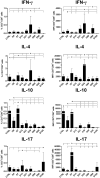CD4+ Th1 and Th17 responses and multifunctional CD8 T lymphocytes associated with cure or disease worsening in human visceral leishmaniasis
- PMID: 38410517
- PMCID: PMC10895669
- DOI: 10.3389/fimmu.2024.1277557
CD4+ Th1 and Th17 responses and multifunctional CD8 T lymphocytes associated with cure or disease worsening in human visceral leishmaniasis
Abstract
Introduction: In VL, a proinflammatory phenotype is typically associated with enhanced phagocytosis and a Th1 mediated immune response resulting in infection control. In contrast, an anti-inflammatory phenotype, associated with a predominant regulatory response, typically enables intracellular multiplication of Leishmania parasites and disease progression.
Methods: To investigate the impact of chemotherapy on Th2 and Th17 immune responses in patients with visceral leishmaniasis (VL), we assessed all combinations of intracellular expression of IFN-γ, IL-10, IL-4 and IL-17 in the CD4+ and CD8+ T cell populations of peripheral blood mononuclear cell (PBMC) samples from patients, after antigenic stimulation with Leishmania lysate, throughout treatment and follow-up. As increases in spleen and liver sizes and decreases in hematocrit, hemogloblin, erythrocytes, monocytes, leukocytes and platelets levels are strongly related to the disease, we studied the correlations between the frequencies of T cells producing the afore mentioned cytokines, individually and in combination, and these variables, as markers of disease or cure.
Results: We found that the frequency of IFN-γ-producingCD4+ T cells increased until the end of chemotherapy with Glucantime® or AmBisome ®, while IL-10, IL-4 and IL-17-producing CD4+ T cells peaked on day 7 following the start of treatment. Although the frequency of CD4+IL-17+ cells decreased during treatment an increase was observed after clinical cure. The frequency of CD4+ T cells producing only IFN-γ or IL-17 correlated with blood monocytes levels. Frequencies of double-producers of IFN-γ and IL-10 or IL-4 correlated positively with eosinophils and platelets levels. Together, this suggest that IFN-γ drives the immune response towards Th1 at cure. In contrast, and associated with disease or Th2 response, the frequency of CD4+ IL-10+ cells correlated positively with spleen sizes and negatively with circulating monocyte levels, while the frequency of CD4+ producing both IL-4 and IL-10 correlated negatively with platelets levels. The frequency of CD8+ single-producers of IFN-γ increased from day 21 to 90 while that of single-producers of IL-10 peaked on day 7, of IL-4 on day 30 and of IL-17, on day 180. IFN-γ expression in CD8+ single- and double-producers of cytokines was indicative of an immune response associated with cure. In contrast, frequencies of CD8+ double-producers of IL-4 and IL-10, IL-4 and IL-17 and IL-10 and IL-17 and producers of three and four cytokines, were associated with disease and were low after the cure. Frequencies of CD8+ T cells producing IFN-γ alone or with IL-17 were positively correlated with platelets levels. In contrast, as markers of disease: 1) frequencies of single producers of IL-10 correlated negatively with leukocytes levels, 2) frequencies of double producers of IL-4 and IL-10 correlated negatively with platelet, leukocyte, lymphocyte and circulating monocyte levels, 3) frequencies of triple-producers of IFN-γ, IL-4 and IL-10 correlated negatively with platelet, leukocyte and neutrophil levels and 4) frequencies of producers of IFN-γ, IL-4, IL-10 and IL-17 simultaneously correlated positively with spleen size, and negatively with leukocyte and neutrophil levels.
Discussion: Our results confirmed that the clinical improvement of VL patients correlates with the decrease of an IL-4 and IL-10 CD4+Th2 response, the recovery of CD4+ Th1 and Th17 responses and the frequency of CD8+ single-producers of IFN-γ and double producers of IFN-γ and IL-17.
Keywords: T-cell subsets; cellular immunity; human visceral leishmaniasis; immunophenotyping; multifunctional.
Copyright © 2024 de Franca, Rodrigues, Barreto, da Cruz, Aragão-Santos, da Silva, de Jesus, Palatnik-de-Sousa, de Almeida and Corrêa.
Conflict of interest statement
The authors declare that the research was conducted in the absence of any commercial or financial relationships that could be construed as a potential conflict of interest. The author(s) declared that they were an editorial board member of Frontiers, at the time of submission. This had no impact on the peer review process and the final decision.
Figures






Similar articles
-
Multifunctional, TNF-α and IFN-γ-Secreting CD4 and CD8 T Cells and CD8High T Cells Are Associated With the Cure of Human Visceral Leishmaniasis.Front Immunol. 2021 Oct 28;12:773983. doi: 10.3389/fimmu.2021.773983. eCollection 2021. Front Immunol. 2021. PMID: 34777391 Free PMC article.
-
Leishmania donovani Nucleoside Hydrolase (NH36) Domains Induce T-Cell Cytokine Responses in Human Visceral Leishmaniasis.Front Immunol. 2017 Mar 7;8:227. doi: 10.3389/fimmu.2017.00227. eCollection 2017. Front Immunol. 2017. PMID: 28321221 Free PMC article.
-
Analysis of Th1 and Th2 cytokines expressing CD4+ and CD8+ T cells in rheumatoid arthritis by flow cytometry.J Rheumatol. 2000 May;27(5):1128-35. J Rheumatol. 2000. PMID: 10813277
-
CD4 T Helper Cell Subsets and Related Human Immunological Disorders.Int J Mol Sci. 2020 Oct 28;21(21):8011. doi: 10.3390/ijms21218011. Int J Mol Sci. 2020. PMID: 33126494 Free PMC article. Review.
-
IFN-γ and IL-17: the two faces of T-cell pathology in giant cell arteritis.Curr Opin Rheumatol. 2011 Jan;23(1):43-9. doi: 10.1097/BOR.0b013e32833ee946. Curr Opin Rheumatol. 2011. PMID: 20827207 Free PMC article. Review.
Cited by
-
Design and development of highly conserved, HLA-promiscuous T cell multiepitope vaccines against human visceral leishmaniasis.Front Immunol. 2025 Mar 31;16:1540537. doi: 10.3389/fimmu.2025.1540537. eCollection 2025. Front Immunol. 2025. PMID: 40230841 Free PMC article.
-
Applications of Osteoimmunomodulation Models in Evaluating Osteogenic Biomaterials.J Funct Biomater. 2025 Jun 11;16(6):217. doi: 10.3390/jfb16060217. J Funct Biomater. 2025. PMID: 40558903 Free PMC article. Review.
-
The F1F3 recombinant chimera induced higher vaccine efficacy than its independent F1 and F3 components against Leishmania (L.) infantum chagasi mice infection.Front Immunol. 2025 Jul 1;16:1598755. doi: 10.3389/fimmu.2025.1598755. eCollection 2025. Front Immunol. 2025. PMID: 40666521 Free PMC article.
References
-
- Leishmaniasis. Available at: https://www.who.int/news-room/fact-sheets/detail/leishmaniasis.
Publication types
MeSH terms
Substances
LinkOut - more resources
Full Text Sources
Research Materials

